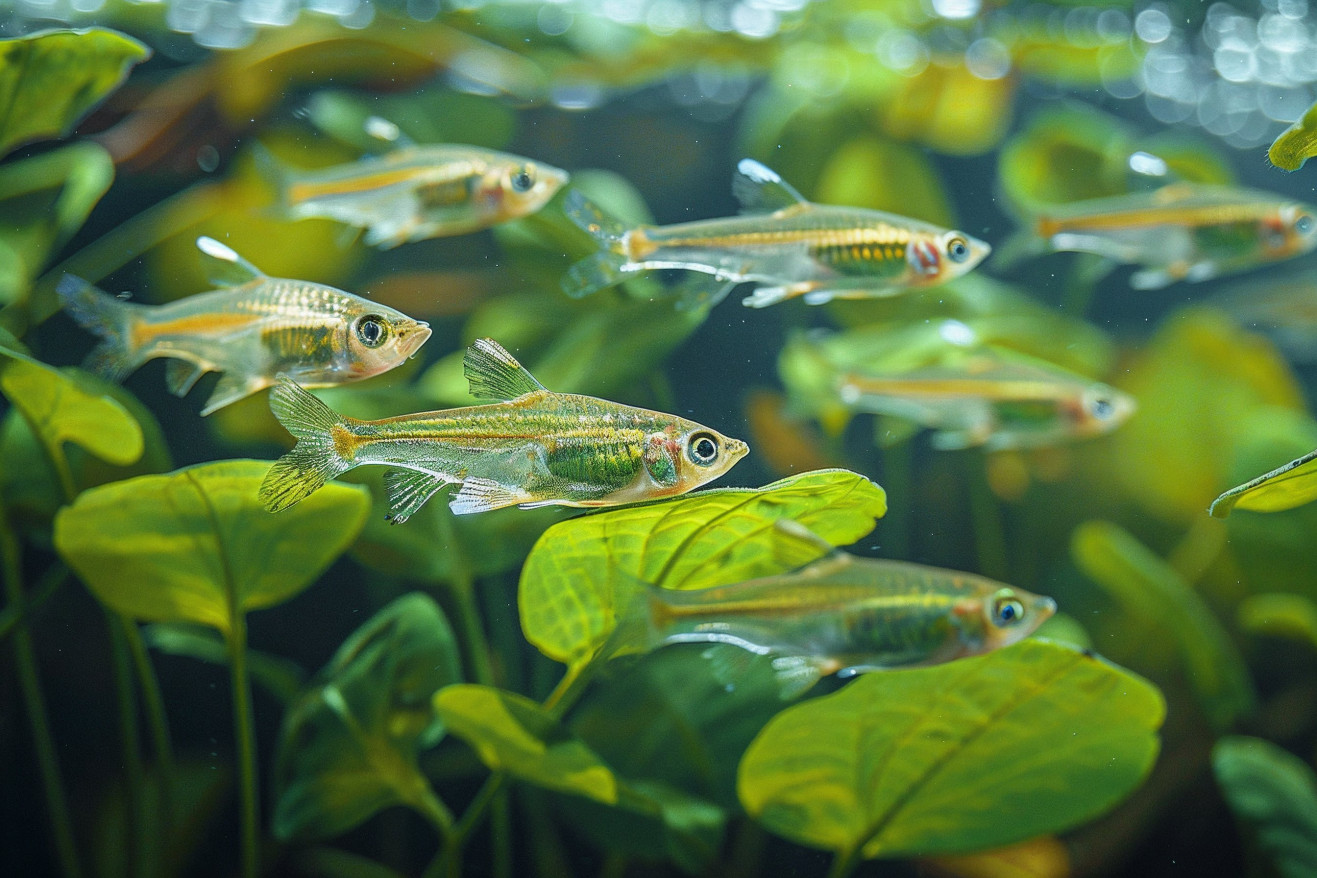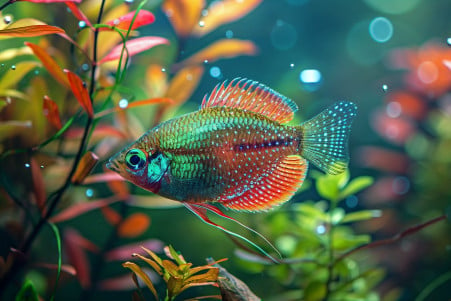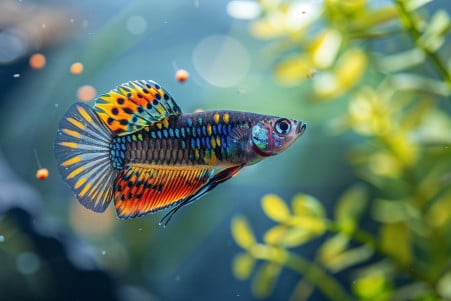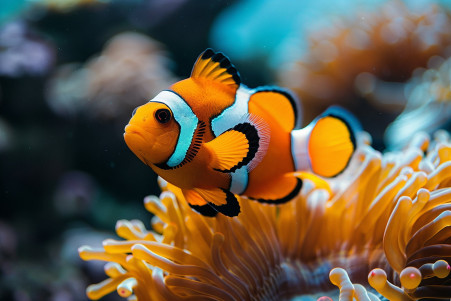What Do Minnows Eat? Exploring Their Diverse Diet in the Wild and in Aquariums
3 March 2024 • Updated 2 March 2024

Despite their small size, minnows have a diverse diet that includes a wide range of foods. These small freshwater fish eat mostly insects, algae, plant matter, and fish eggs. In an aquarium setting, minnows can eat store-bought fish food, algae, and live or frozen bloodworms and brine shrimp. However, it’s important to make sure they aren’t overfed.
In order to get a complete picture of what minnows eat, we will look at a variety of research from the fields of ecology, animal behavior, and ichthyology. We will cover everything from what minnows eat in the wild to how their diets change with the seasons and their important role in their ecosystems.
By combining information from these different scientific disciplines, we hope to give a thorough overview of what minnows eat and how their eating habits impact their environment.
What do minnows eat?
The Many Different Diets of Minnows in the Wild
In the wild, minnows live in a variety of ecosystems, including swamps, rivers, ponds, and lakes, and their diet reflects their opportunistic feeding behavior. A report by Turtle Bay explains that these omnivorous fish eat a combination of mosquitoes, algae, and small crustaceans, which shows how they can adapt to the food that’s available in their environment.
The diet of minnows varies greatly by species and location, as Hepper explains, and can include algae, insects, plankton, and even smaller fish or crustaceans, which they grind up with a pharyngeal pad.
Some species, including the Cutlip, Desert, Cheat, and Suckermouth minnows, have diets that are closely tied to their habitats. For example, young minnows often eat soft algae and plankton, which provide them with the nutrients they need to grow.
A report by A-Z Animals explains that the availability of these resources is a key factor in the diet of minnows. Other species, like the Bluntnose and Fathead minnows, are generalists that eat a wide variety of foods, including detritus, insects, and plankton, which helps them survive in the wild.
For people who want to feed minnows in captivity, it’s important to know about these natural diets. Not only is it important to make sure that the fish are getting the nutrients they need, but it’s also interesting to make sure that their diet is as varied and complex as it is in the wild.
Best Diet for Healthy Minnows in Captivity
Successfully keeping minnows in captivity hinges on an understanding of their nutritional requirements and feeding preferences. As omnivores, minnows require a diet that includes both animal and plant-based foods. A high-quality commercial food formulated for tropical fish or goldfish is a good staple, according to researchers.
To avoid nutritional deficiencies, it’s important to supplement this with live or frozen foods like brine shrimp or bloodworms to ensure a well-rounded diet that reflects what minnows eat in the wild.
Overfeeding is a common problem when it comes to minnows, and it can lead to water quality issues and health problems for the fish.
Overfed fish produce waste that can cause water quality to deteriorate, and this can lead to high mortality rates in captive minnows.
To avoid this, it’s best to feed minnows small amounts of food twice a day and remove any uneaten food after about 5 minutes, according to A-Z Animals. The amount of food you feed them should be based on the size of the tank and the number of minnows living in it, but a good rule of thumb is to feed them a pinch of food at each feeding if you’re keeping a small group of minnows.
By making sure that their diet is well-rounded and that you’re feeding them properly, you can ensure that your minnows will be healthy and happy. This will also help you understand the nuances of their care, including how their dietary needs change throughout the year.
Seasonal Diet Changes in Minnows
One of the ways that minnows demonstrate their adaptability is through their ability to change their diet based on the season. This is a clear example of their ability to adapt and survive.
For example, a review published in Reviews in Fish Biology and Fisheries found that Neotropical stream-dwelling minnows have shown a great deal of feeding plasticity, which helps them survive in the face of food limitation during the dry season. This plasticity allows the minnows to switch between different food sources based on what’s available, ensuring that they can find food and live to see another day.
Meanwhile, Zahn Seegert’s work in the Grand Canyon section of the Colorado River found that minnows, including Fathead Minnows, change their diet seasonally to eat more terrestrial vegetation and detritus during periods of high turbidity, like the summer monsoon.
This seasonal change in diet is important for the survival of minnow populations and has implications for how minnows are fed in captivity. Making sure that their diet changes in the same way it does in the wild can help ensure that the conditions that have allowed minnows to survive and thrive are being accurately recreated.
Meanwhile, a paper available through PMC found that in Tonle Sap Lake, seasonal changes in water levels have a big impact on the diets of fish, including minnows. This shows that minnows are well-adapted to seasonal changes and that their diets can and should change throughout the year to reflect this. This means that in captivity, feeding should be adjusted to reflect the changes in food availability that would be happening in the wild.
Ecosystem Impact of Minnow Diets
Minnows are a key part of the aquatic food chain, connecting primary producers to higher trophic levels. As Boreal Forest explains, these small, but numerous fish are primary consumers that eat plant material, algae, and zooplankton, and are also important food for birds of prey, mammals, and other fish. Because they are both consumers and consumed, minnows have an important impact on the health and stability of the ecosystems they inhabit.
Their varied diet helps keep populations in check in their ecosystems, especially since some minnows, like the Lake Chub, eat benthic (bottom-dwelling) detritus or algae, which can help keep algae in check and contribute to nutrient cycling. By eating insects and other small aquatic organisms, minnows help keep invertebrate populations in check, prevent overpopulation, and help maintain a healthy and dynamic ecosystem, according to JRank.
Human-induced changes in minnow habitats and food sources have also impacted minnow populations and their diets. According to Boreal Forest, changes to land use and stream habitat have led to the decline or extinction of many minnow species.
These changes not only threaten the minnows themselves, but also the complex ecosystems they are part of, which emphasizes the importance of preserving natural habitats so that these important ecological roles can continue. This is an important point to keep in mind as we learn more about how minnows feed and the strategies they use to find food.
Foraging Innovations: How Minnows Eat in the Wild
In the rich and varied environment of freshwater ecosystems, minnows have evolved a number of foraging innovations to find, catch, and eat their prey.
Cynthia A. Paszkowski’s research demonstrates that minnows have evolved a range of foraging modes. For example, some species, such as the pumpkinseed, are particulate feeders, which means they prefer larger prey, while Fathead minnows are a combination of particulate and filter feeders, which means they are good at catching both larger, slower-moving prey and smaller prey.
These different foraging modes are an advanced response to the availability of different food sources and help minnows maximize their energy intake.
In addition, environmental factors, such as light levels, also impact minnows’ feeding behavior. A study in the Journal of Experimental Biology found that minnows are more successful at capturing prey, such as Daphnia, in brighter light. Their activity levels change with the amount of light available, which in turn changes how efficient they are at foraging.
Moreover, minnows are known to be important in biological control, especially when it comes to controlling mosquito populations by eating mosquito larvae. This not only demonstrates their ecological importance, but also shows how they can be used to help humans control populations of pests.
These foraging adaptations, which are so closely linked to the environment, ensure that minnows are able to meet their nutritional needs, which are essential for their survival and ability to reproduce.
Keeping Minnows Healthy: What They Need to Eat
Like all fish, minnows need a precise combination of macronutrients and micronutrients to support growth, reproduction, and overall health. Proteins are used for tissue repair and growth, while lipids provide energy and essential fatty acids that are important for overall health and reproduction.
Carbohydrates are used for energy and to fuel daily activities, but they are less important than proteins and lipids. Vitamins and minerals are micronutrients that are also important for overall health, including bone development and metabolic processes.
In the wild, minnows get these nutrients from a varied diet that includes plant material, insects, and small crustaceans, which helps ensure they get the right balance of essential amino acids, fatty acids, and other micronutrients. The journal Freshwater Aquaculture notes that the quality and quantity of proteins, lipids, and vitamins in the diet have a significant impact on fish performance, indicating that these nutrients are important for overall fish health.
In captivity, you can provide a balanced diet for your minnows by feeding them high-quality commercial fish food and supplementing it with live or frozen foods like brine shrimp and spirulina, according to Algone and RateMyFishTank.com.
This will help ensure that your minnows get the same variety of foods they would in the wild and that they get all the nutrients they need. A balanced diet will help your minnows live long, healthy lives and will help them resist disease while showing off their best colors and activity levels.
So, whether they’re in the wild or living in an aquarium, a balanced diet is key to keeping your minnows healthy.
A Look Back at the Varied Diet of Minnows: Summary
In this article, we’ve taken a look at the many different things that minnows eat, from insects to plant matter to brine shrimp to fish eggs. As Sciencing’s article explains, these small but important members of the Cyprinidae family are known for their flexible feeding habits in the wild and in captivity.
Meanwhile, Bio Explorer points out that minnows are both predators and prey in their ecosystems, which can have a big impact on the food web.
For those who keep minnows in captivity, one of the biggest challenges is making sure that their diet is as close to their natural one as possible so that they can thrive without being overfed. This is especially important because overfeeding can be a big problem with minnows and can lead to a variety of health issues.
This is just one example of how complex it can be to care for minnows, whether they’re being kept for scientific research or as pets.
In the end, it’s clear that feeding is one of the most important factors in keeping a healthy population of minnows. It’s also clear that it’s important to keep studying and learning more about what minnows eat and how their feeding habits affect their ecosystems.
By doing this, we can learn more about the complex food webs that exist in our waterways and the roles that even the smallest creatures play in them.


